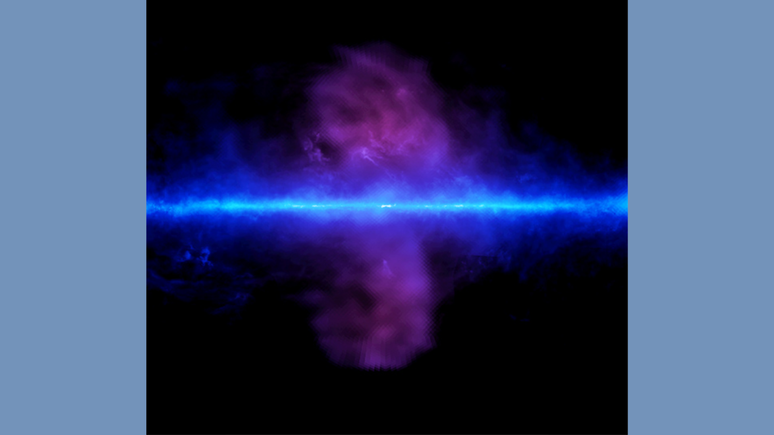In 2010, scientists using the Fermi gamma-ray space telescope, operated by NASA, identified enigmatic structures above the Milky Way. Known as Fermi bubbles, these structures span 25,000 light-years and lie above and below the galactic disk, near its center. Although large gamma-ray emissions can be observed, the bubbles are not visible to the naked eye and are only detected by specific instruments.
The discovery caught the attention of the scientific community, which has since sought to understand the nature and origin of these formations. The bubbles have well-defined edges and a symmetrical shape, characteristics that have led to the hypothesis that rapid energy release was a factor in their creation. However, the origin and precise moment of its formation remain mysterious.
Our galaxy is making bubbles! Seen in gamma-ray light from our Fermi satellite, this double bubble may be millions of years old, stretching 50,000 light-years from tip to tip. 🌌🛰️ #NationalBubbleGumDay #StopFriday https://t.co/CT3f3LxEVz pic.twitter.com/56FY4He2q7
— NASA Universe (@NASAUniverse) February 4, 2022
The enigma of Fermi bubbles in the Milky Way
The Fermi bubbles were visible only after removing the gamma-ray haze present in the observed region. This haze, moving at nearly the speed of light, interacted with gas, dust and light in the galaxy, complicating direct visualization of the bubbles. One of the initial theories suggested that the structures could be traces of the activity of the supermassive black hole located at the center of the galaxy, known as Sagittarius A*.
According to this hypothesis, the material engulfed by the black hole, such as a cloud of gas, could have been processed and ejected in the form of high-energy jets. Another theory raised the possibility that stellar winds and supernovae in an intense process of star formation in the galactic center would have released the energy necessary for the bubbles to appear.
Over the years, several studies have attempted to clarify the formation of Fermi bubbles. In 2023, scientists at Tokyo Metropolitan University proposed that winds from the central supermassive black hole could have energized the surrounding gas, causing reverse shocks responsible for its creation. These shocks would be complicit in the rise in temperatures observed in the bubbles.
“By comparing the results of numerical simulations with observations, we indicate that the bubbles were created by a fast wind coming from the galactic center because it generates a strong reverse shock and reproduces the temperature peak observed there.” reported the TMU study in the scientific journal Monthly notices of the Royal Astronomical Society.
The results of numerical simulations corroborated this hypothesis, however, they did not exhaust the argument. Many scientists are still studying other explanations, and the data collected continues to be analyzed for a more complete understanding.
Undetermined origin
The lack of consensus on the origin of Fermi bubbles arises from the complexity involved in space observations and the subtlety of intergalactic phenomena. Observations made by Glast and other initiatives have only begun to uncover the vast amount of information still hidden in the galactic center. Other phenomena, such as intense cosmic ray activity and complex gravitational interactions, make it difficult to obtain accurate data.
Although progress has been significant, Fermi bubbles continue to represent an intriguing challenge for modern astrophysics. Research continues to reveal not only the nature of these structures, but also to understand the role they play in contextualizing galactic evolution.
Looking to the future, Fermi bubble research is poised to benefit from new technological and methodological developments. More powerful and sophisticated telescopes could provide even more detailed and potentially game-changing observations of these phenomena.
Source: Terra
Rose James is a Gossipify movie and series reviewer known for her in-depth analysis and unique perspective on the latest releases. With a background in film studies, she provides engaging and informative reviews, and keeps readers up to date with industry trends and emerging talents.



-to4mi28diwq8.jpg)



